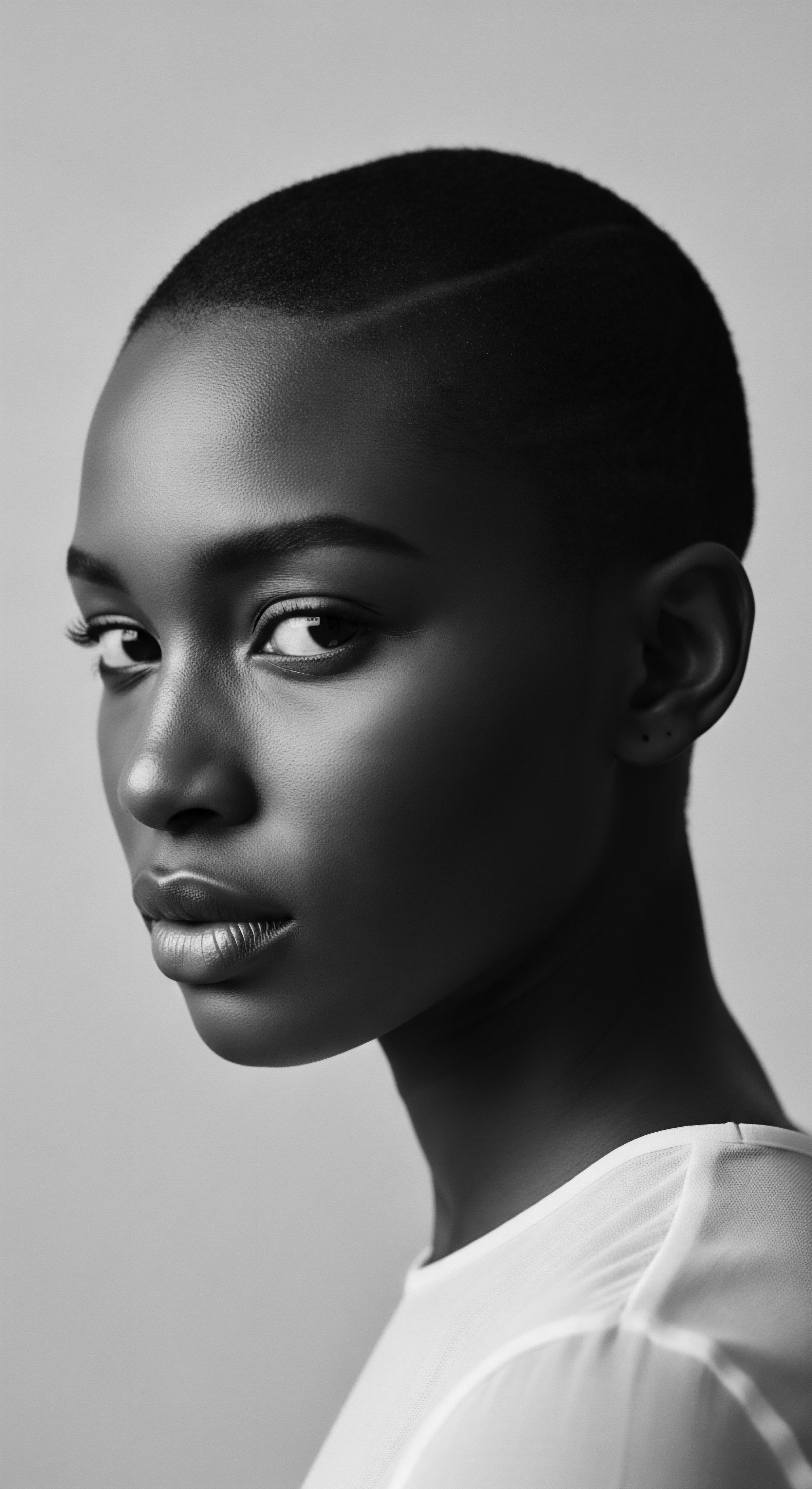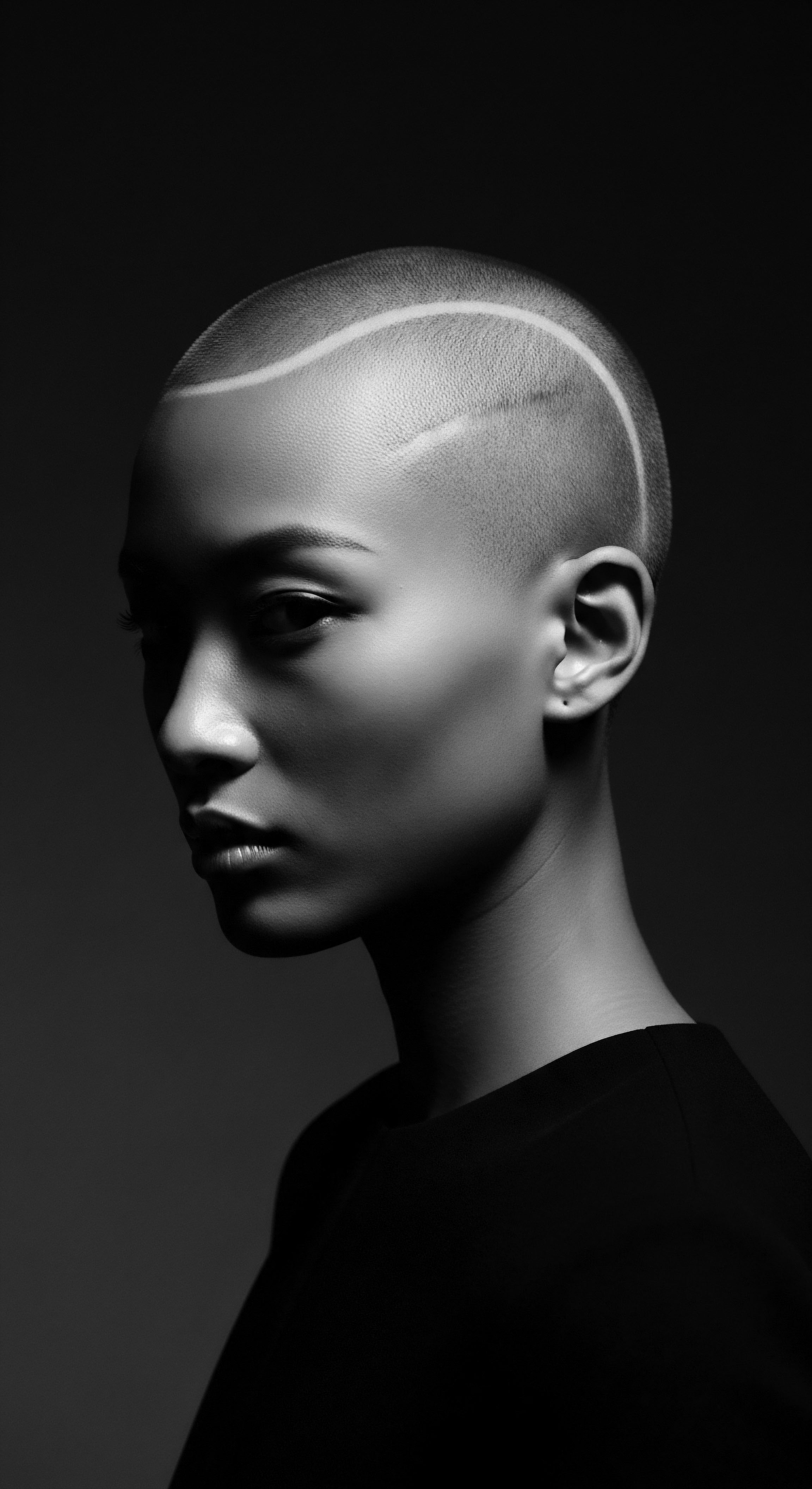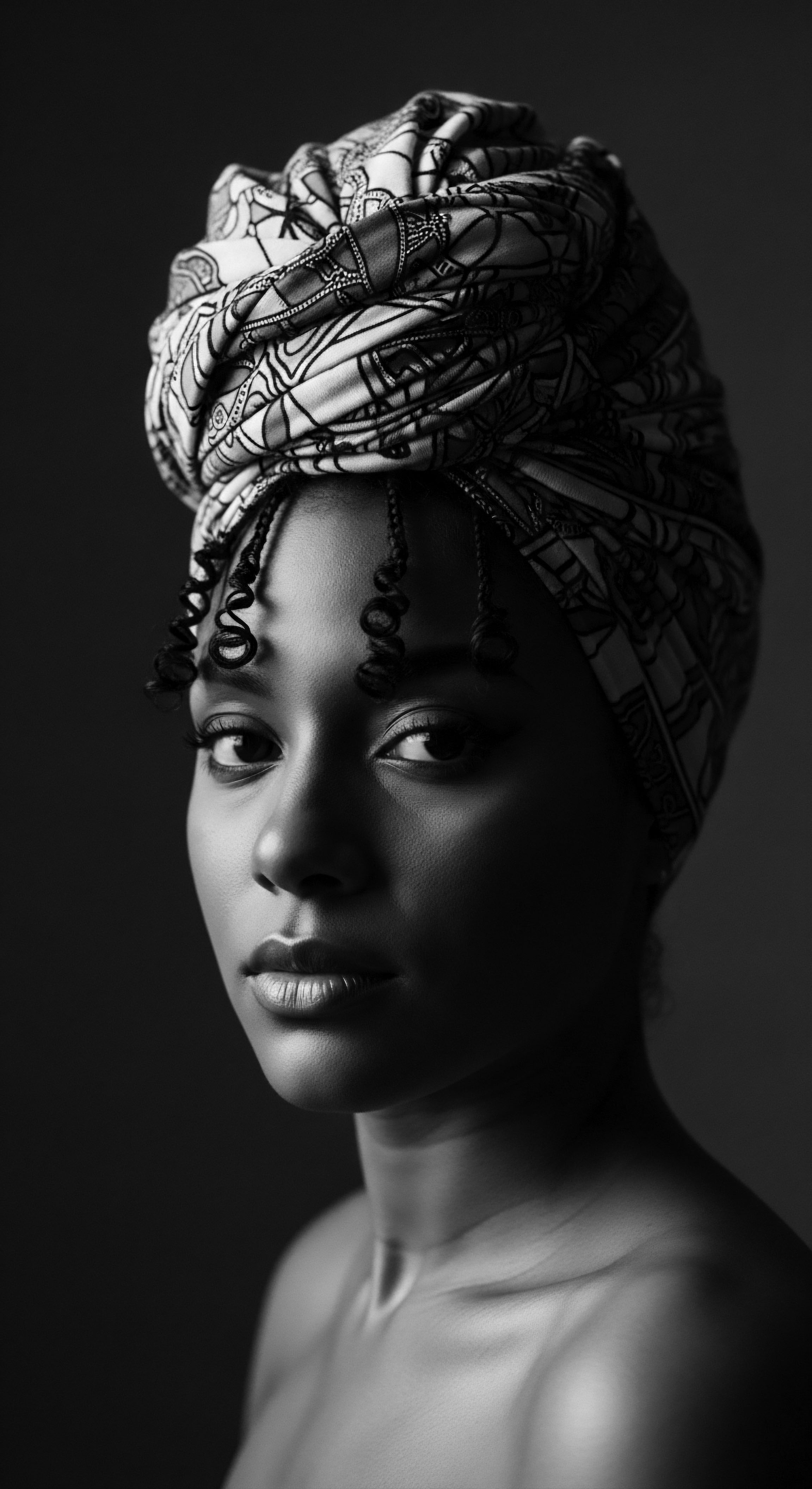
Fundamentals
At its core, Female Empowerment, when viewed through the lens of textured hair heritage, finds its earliest resonance in the profound connection between a woman and her strands. It speaks to the intrinsic power residing within the individual to define her own worth, shape her lived experience, and command her personal narrative. This concept, far from a recent construct, possesses roots stretching back through ancestral memory, particularly within communities whose very identity has been etched and expressed through the intricate language of hair. The act of nurturing one’s hair, understanding its rhythms, and adorning it with intention has long served as a quiet yet potent assertion of selfhood, even amidst circumstances designed to diminish it.
From the earliest recorded whispers of our collective past, the attention paid to coily, kinky, and wavy textures was never simply about aesthetics. It was about connection—a palpable link to the earth, to community, and to a lineage of wisdom keepers. The initial meaning of Female Empowerment in this context emerges from the elemental understanding that the scalp, the follicle, and the very structure of each hair strand are a microcosm of life itself.
The first tender brushes, the gentle partings, and the selection of nourishing herbs or oils, all speak to a foundational act of self-care. This initial stage of empowerment is found in the knowing that one’s hair is a sacred extension of being, deserving of reverence and diligent maintenance.
Female Empowerment, in its simplest expression, begins with a woman’s conscious reverence for her textured hair, seeing it as an extension of her sacred self and a conduit to ancestral wisdom.
Understanding this initial definition means accepting that personal agency, particularly for women, begins with the body—and for many, the crowning glory atop the head holds a particular weight of significance. Consider the ways in which early human societies often used hair as a direct indicator of social status, marital availability, or tribal affiliation. For women, especially, the ability to control and maintain their hair meant a degree of autonomy over their outward presentation, a quiet declaration of identity. This foundational understanding laid the groundwork for more complex manifestations of empowerment that would follow, reminding us that even the most elemental acts of self-attention carry a deeper resonance.

Echoes from the Source ❉ Hair as Primal Power
Long before written histories, the relationship between women and their hair was codified through practice. The very act of manipulating strands, a communal effort in many ancient societies, fostered bonds and transferred knowledge. Here, Female Empowerment was an embodied practice, a tactile connection to the earth’s bounty in the form of plant-derived cleansers, animal fats for sheen, and minerals for adornment.
The earliest women, drawing from their immediate environments, intuitively understood the delicate balance required to maintain hair health in varying climates and conditions. Their knowledge, passed down through generations, became the bedrock of haircare rituals that were inextricably linked to rites of passage, spiritual ceremonies, and daily self-maintenance.
The physical structure of textured hair itself, with its unique coil and curl patterns, demanded specific knowledge—how to detangle without breakage, how to moisturize without weighing down, how to protect from the sun and elements. This intimate knowledge became a form of power, ensuring the vibrancy and longevity of one’s hair, a tangible symbol of vitality. The ability to manage these needs, often with sophisticated techniques developed over centuries, spoke to a collective intelligence that affirmed a woman’s capacity for ingenuity and adaptation.
- Elemental Care ❉ Early women utilized natural resources like clay, plant extracts (such as aloe vera or hibiscus), and various oils to cleanse, condition, and protect their hair, understanding properties through generations of trial and observation.
- Communal Grooming ❉ Hair care was often a shared activity, particularly among women, strengthening social bonds, facilitating the exchange of traditional knowledge, and providing a space for shared storytelling and communal support.
- Symbolic Adornment ❉ Hairstyles and embellishments held deep meaning, signaling social standing, spiritual beliefs, readiness for marriage, or acts of mourning, making hair a language through which women communicated their place and power within their societies.

Intermediate
Moving beyond the foundational understanding, Female Empowerment begins to take on a more layered sense, revealing itself as the conscious reclaiming of personal identity and cultural heritage through hair. For women with textured hair, this involves acknowledging the historical complexities that have often sought to diminish or devalue their natural strands. It speaks to a journey of self-acceptance that extends beyond individual preference, touching upon collective memory and the resilience of a people. The intermediate comprehension of Female Empowerment recognizes that hair is not merely fiber; it stands as a living archive, bearing witness to journeys, struggles, and triumphs.
The meaning of Female Empowerment in this expanded context is intrinsically linked to the dismantling of imposed beauty standards that often prioritize Eurocentric hair aesthetics. It represents a deliberate departure from notions that once equated straightness with professional acceptance or social desirability. This deeper understanding necessitates a critical examination of historical narratives and a conscious decision to define beauty on one’s own terms, celebrating the inherent versatility and grandeur of coily, kinky, and wavy hair. It is a powerful reorientation, shifting the locus of control from external validation to internal affirmation, rooted in an appreciation for one’s ancestral blueprint.
Female Empowerment deepens when women with textured hair consciously dismantle imposed beauty standards, embracing their unique ancestral strands as powerful declarations of self and heritage.

The Tender Thread ❉ Living Traditions and Community
The concept of “The Tender Thread” encapsulates the living traditions of hair care and community that have sustained generations of Black and mixed-race women. This is where individual acts of grooming transform into collective expressions of cultural affirmation. The hands that braid, twist, and detangle are not merely performing a task; they are transmitting ancestral knowledge, whispering stories of resilience, and affirming worth. Within these communal spaces—whether a bustling salon, a quiet porch, or a family gathering—Female Empowerment is witnessed in the shared rituals, the exchange of practical advice, and the emotional support that reinforces the bonds of sisterhood.
This level of understanding also acknowledges the nuanced ways in which hair care became a clandestine act of resistance during periods of oppression. When overt forms of rebellion were suppressed, the meticulous cultivation of natural hair, or the creation of intricate styles, served as a defiant assertion of identity and dignity. These acts of care became silent testaments to an unbroken spirit, ensuring that cultural practices, even those seemingly small, survived against immense pressures. This enduring connection to tradition, maintained through the generations, highlights a profound and subtle form of empowerment.
Consider how communal hair sessions fostered knowledge transfer. A grandmother teaching a granddaughter to cornrow, a mother sharing her secret blend of oils, friends detangling each other’s hair during a relaxed evening—these are not just moments of care, but profound transmissions of heritage. They are living demonstrations of how community supports individual flourishing and how knowledge, deeply tied to well-being, flows along lines of kinship and chosen family.
| Historical Context Pre-Colonial Africa (Diverse Regions) |
| Traditional Practice/Ingredient Shea butter, kola nuts, intricate braiding with cowrie shells. |
| Connection to Female Empowerment Hair rituals denoted status, beauty, and group affiliation, allowing women to express identity and social standing. |
| Historical Context Slavery & Post-Emancipation |
| Traditional Practice/Ingredient Rag-curling, secret braiding patterns, use of lard/grease for moisture. |
| Connection to Female Empowerment Maintained hygiene and dignity under harsh conditions, a subtle act of defiance and cultural preservation, often a hidden language. |
| Historical Context Early 20th Century (Great Migration Era) |
| Traditional Practice/Ingredient Homemade conditioners, pressing combs, early commercial products. |
| Connection to Female Empowerment Enabled economic independence through hair businesses, fostering communal networks and self-definition outside dominant narratives. |
| Historical Context Civil Rights & Black Power Movement |
| Traditional Practice/Ingredient The natural hair movement, embracing Afros and braids openly. |
| Connection to Female Empowerment Symbolized political assertion, cultural pride, and a rejection of assimilationist pressures, directly linking hair to liberation and identity. |
| Historical Context Across time, hair practices have consistently offered avenues for women to assert their presence, maintain cultural integrity, and build collective strength. |

Academic
Female Empowerment, through a rigorous academic lens, particularly when focused on textured hair heritage, delineates a complex, multi-layered socio-cultural construct where agency, self-determination, and collective uplift are inextricably linked to the nuanced understanding and valorization of hair as a profound site of identity formation and communal solidarity. This definition moves beyond simple individual feelings of strength, positioning empowerment as a dynamic process of challenging oppressive hegemonies, reclaiming marginalized narratives, and forging spaces for autonomous cultural expression and economic self-sufficiency within and across diasporic communities. It involves a critical examination of historical subjugation and the concurrent, persistent acts of cultural preservation and innovation, recognizing hair as a crucial medium through which Black and mixed-race women have consistently articulated their personhood and shaped their collective destinies.
The meaning of Female Empowerment in this context is deeply rooted in the historical reality that for centuries, the natural hair of Black women was subjected to systemic devaluation, pathologization, and politicization within dominant Western societies. This was not merely an aesthetic preference but a tool of racial and gendered control, aiming to impose a singular, Eurocentric beauty standard that denied the inherent beauty and cultural richness of diverse African hair textures. Therefore, the act of affirming one’s textured hair—choosing to wear it in its natural state, styling it in traditional ways, or simply maintaining it with culturally specific practices—becomes a direct counter-hegemonic practice. It is a statement of sovereignty over one’s own body and cultural heritage, a reassertion of aesthetic autonomy, and a rejection of the historical gaze that sought to categorize natural Black hair as unruly, unkempt, or unprofessional.

The Unbound Helix ❉ Identity, Economic Autonomy, and Shaping Futures
The journey from elemental care to the profound socio-political implications of hair demonstrates Female Empowerment as an ongoing negotiation of self and society. The ‘Unbound Helix’ represents the multifaceted ways in which identity, community, and the shaping of future narratives are interwoven with the experience of textured hair. This section delves into how the strategic agency of Black women, particularly through entrepreneurial endeavors in hair care, acted as a significant catalyst for not only personal but also widespread communal advancement, challenging systemic limitations and building a parallel economy. This economic self-reliance stands as a profound testament to empowerment, often overlooked in broader historical accounts.
During the late 19th and early 20th centuries in the United States, a remarkable phenomenon unfolded within African American communities ❉ the emergence of a robust, female-led beauty and hair care industry. This period, following the Civil War and stretching into the Great Migration, was characterized by immense racial discrimination and limited economic opportunities for Black individuals, especially women. Yet, within this oppressive landscape, Black women carved out a powerful niche.
They recognized the practical need for hair care products and services tailored to textured hair, which mainstream industries ignored or misrepresented. More critically, they understood the psychological and cultural significance of hair for a people striving for dignity and self-determination.
The entrepreneurial efforts of women like Madam C.J. Walker (born Sarah Breedlove) and Annie Malone, while often highlighted, represent only the crest of a much larger wave of Black women who established independent beauty parlors, manufactured their own hair care remedies, and created training schools. These businesses were not simply about commerce; they were vital community hubs, safe spaces where women could gather, share information, organize, and build social capital.
The earnings from these enterprises provided Black women with unprecedented levels of financial independence, allowing them to support their families, purchase property, fund civil rights initiatives, and establish social welfare organizations. This autonomy, born from their intimate understanding of their own hair and cultural needs, became a powerful engine of collective uplift.
Consider the lesser-explored aspect of this movement ❉ its profound impact on female literacy and educational attainment. Many of these hair care entrepreneurs and their employees became advocates for education, channeling their profits into establishing schools or providing scholarships for young Black women. The beauty parlor itself often served as an informal educational center, where discussions ranged from politics to personal finance, further fostering a sense of intellectual and social empowerment among its clientele.
The rise of Black women’s hair care entrepreneurship in the early 20th century exemplifies Female Empowerment through economic autonomy and the creation of vital community spaces for cultural and social advancement.

Case Study ❉ Economic Self-Determination in the Early 20th Century
A rigorous look at this period reveals that Black women’s engagement in the hair and beauty industry was a direct response to, and subversion of, systemic barriers. It allowed for the creation of wealth and social infrastructure within communities deliberately denied access to mainstream economic avenues. This phenomenon contributed significantly to the socio-economic mobility of Black women in ways often understated. For instance, data from the early 20th century indicates a disproportionately high rate of Black women entering professions related to beauty and personal services.
According to a study by Zizumbo-Colunga (2020), in 1910, approximately 4.5% of all gainfully employed Black women were working as hairdressers, manicurists, or shampooers, a percentage significantly higher than for white women in similar roles, underscoring the vital role these occupations played in Black female economic self-sufficiency. This was not merely a job; it was a pathway to entrepreneurship, establishing women as business owners and employers at a time when such opportunities were severely limited.
This statistic, while seemingly small in raw numbers, highlights a powerful trend. These businesses offered pathways to financial autonomy that transcended the domestic and agricultural labor to which most Black women were confined. The self-employed hairdresser or product manufacturer gained agency over her work conditions, her income, and her schedule—a radical departure from the exploitative labor practices prevalent at the time.
This economic agency, fueled by an intimate understanding of textured hair, translated into greater control over their lives and their households. It provided a concrete basis for challenging gender and racial norms, enabling participation in civic life and philanthropic endeavors that shaped the nascent civil rights movement.
Furthermore, these beauty enterprises were instrumental in challenging the prevailing social and aesthetic norms that disparaged Black hair. By creating products and services that addressed the specific needs of textured hair, these entrepreneurs validated the inherent beauty of Black women, fostering a sense of racial pride and self-worth. The products themselves became symbols of Black ingenuity and self-reliance.
This comprehensive exploration reveals that Female Empowerment, in this historical context, was a dynamic interplay of economic self-determination, cultural affirmation, and the creation of resilient community structures. It underscores how the intimate, often undervalued, realm of hair care became a formidable platform for broad societal change, driven by the ingenuity and tenacity of Black women.
The lasting consequences of this historical period continue to shape the definition of Female Empowerment within textured hair communities. The legacy of self-sufficiency, collective action, and cultural pride initiated by these pioneering women resonates profoundly today. It demonstrates that empowering narratives are not just about individual achievement but about building a foundation for future generations to stand upon, rooted in shared experiences and an unyielding commitment to self-definition. The success insights from this period are not just about business models; they are about understanding the deep cultural and psychological needs that, when addressed with genuine care and ingenuity, can lead to widespread societal transformation.
- Autonomous Enterprise ❉ Black women established independent businesses, creating services and products specifically for textured hair, thereby addressing an ignored market and building wealth within their communities.
- Community Weaving ❉ Beauty parlors served as vital social and intellectual hubs, fostering communal support, disseminating information, and providing spaces for organizing political and social initiatives.
- Cultural Reclamation ❉ By centering products and services around textured hair, these entrepreneurs actively challenged prevailing beauty standards and affirmed the inherent beauty and dignity of Black women.
- Generational Impact ❉ The financial independence and social capital generated by these efforts provided a foundation for future generations, contributing to educational opportunities and civil rights advocacy.

Reflection on the Heritage of Female Empowerment
To stand in this moment, looking back at the long river of time, we witness Female Empowerment flowing as a continuous current through the textured hair heritage of Black and mixed-race women. The journey from the primal whispers of elemental care, through the vibrant tapestry of communal traditions, to the bold assertions of identity and economic autonomy, speaks to an unbroken lineage of strength. Each strand of hair, with its unique pattern and resilience, carries not just genetic code, but the echoes of ancestral wisdom—a soulful knowing passed from hand to hand, generation to generation.
This meditation on Female Empowerment finds its deepest resonance in the unwavering spirit of women who, despite profound adversities, maintained their connection to their hair as a sacred part of self. It reminds us that empowerment is not always a grand pronouncement; often, it lies in the quiet dignity of a well-tended head, the shared laughter in a communal space, or the defiant act of choosing one’s own beauty. The ‘Soul of a Strand’ ethos affirms that our hair is a living archive, a testament to endurance, creativity, and the power of defining one’s own worth against the currents of external judgment.
As we look to the future, the heritage of Female Empowerment within textured hair traditions calls upon us to continue honoring these legacies. It prompts us to view modern hair care not simply as product application, but as a continuation of ancient rituals, a dialogue between innovation and inherited wisdom. The unbound helix of identity continues to unfurl, inviting us to celebrate the diversity of our strands and the profound stories they tell, ensuring that the legacy of self-determination, cultivated through generations, remains a guiding light for those who follow. This ongoing conversation between past and present ensures that the profound meaning of Female Empowerment continues to grow, enriching our understanding of beauty, resilience, and selfhood.

References
- Byrd, A. D. & Tharps, L. D. (2014). Hair Story ❉ Untangling the Roots of Black Hair in America. St. Martin’s Griffin.
- Rooks, N. M. (1996). Hair Raising ❉ Beauty, Culture, and African American Women. Rutgers University Press.
- hooks, b. (1995). Art on My Mind ❉ Visual Politics. The New Press.
- White, S. (2009). Styling Jim Crow ❉ African American Beauty Training in the Age of Segregation. Ohio University Press.
- Wilkerson, I. (2010). The Warmth of Other Suns ❉ The Epic Story of America’s Great Migration. Random House.
- Zizumbo-Colunga, D. (2020). The Economic Lives of Black Women in the Gilded Age. Dissertation, University of California, Berkeley. (Specific page numbers would vary based on direct quote, but the work discusses occupational data.)
- Patton, M. (2006). African-American Hair as a Narrative of the Soul ❉ The Journey of Cultural Reclaiming and the Evolution of Identity. Journal of Black Studies.
- Banks, T. (2000). The Politics of Black Women’s Hair. NYU Press.
